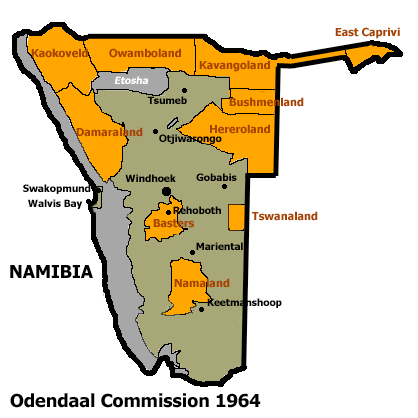East Caprivi
| Republic of East Caprivi | ||||||||||
| Republiek van Oos-Caprivi Republik Ostcaprivi | ||||||||||
| Bantustan | ||||||||||
| ||||||||||
 Flag
 Coat of arms
| ||||||||||
 Allocation of Land to bantustans according to the Odendaal Plan. East Caprivi is in the top right corner. | ||||||||||
| Capital | Katima Mulilo | |||||||||
| Languages | Lozi English Afrikaans German | |||||||||
| Political structure | Bantustan | |||||||||
| History | ||||||||||
| • | Self-government | 1972 | ||||||||
| • | Re-integrated into Namibia | May 1989 | ||||||||
| Currency | South African rand | |||||||||
| ||||||||||
East Caprivi was a bantustan in South West Africa (present-day Namibia), intended by the apartheid government to be a self-governing homeland for the Lozi people. It was set up in 1972 and self-government was granted in 1976. The homeland was renamed Lozi soon after. Not like the other homelands in South West Africa, Lozi was directly administrated through the Department of Bantu Administration and Development in Pretoria.[1]
Lozi, like other homelands in South West Africa, was abolished in May 1989 at the start of the transition to independence.
See also
- Apartheid
- Leaders of East Caprivi
- Caprivi Liberation Army[2]
- Free State of Caprivi Strip/Itenge[3]
References
- ↑ Lenggenhager, Luregn (2015-05-04). "Nature, War and Development: South Africa's Caprivi Strip, 1960–1980". Journal of Southern African Studies. 41 (3): 467–483. ISSN 0305-7070. doi:10.1080/03057070.2015.1025337.
- ↑ Forrest, Joshua B. (2003). Subnationalism in Africa: Ethnicity, Alliances, and Politics. Lynne Rienner Publishers. p. 188. ISBN 1-58826-227-8.
- ↑ "Caprivi Liberation Front". Federation of American Scientists. Retrieved 10 April 2009.
Coordinates: 17°46′10″S 24°12′49″E / 17.76944°S 24.21361°E
This article is issued from
Wikipedia.
The text is licensed under Creative Commons - Attribution - Sharealike.
Additional terms may apply for the media files.